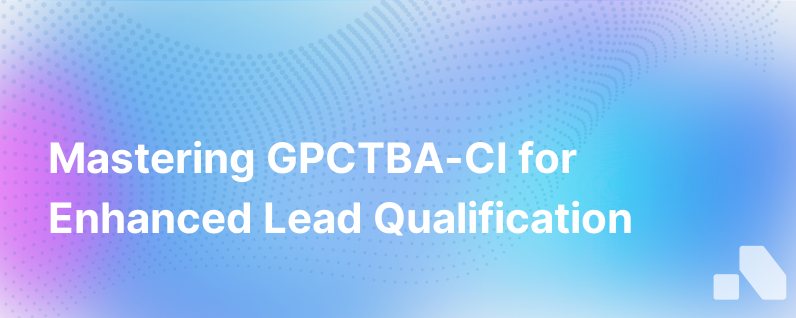
In the dynamic landscape of B2B sales, having a systematic approach to qualify leads is paramount. The advent of customer-centric sales paradigms emphasizes the importance of understanding the buyer's journey and aligning it with sales strategies. Among these, HubSpot's GPCTBA/C&I framework stands out as a comprehensive approach for qualifying leads. It delineates key aspects that sales representatives should evaluate to ensure that they are focusing on the most promising prospects. GPCTBA/C&I is an acronym that breaks down into Goals, Plans, Challenges, Timeline, Budget, Authority, Negative Consequences, and Positive Implications.
Let's dive into this systematic approach and understand how each component plays a vital role in evaluating sales opportunities:
Goals
The 'G' in GPCTBA/C&I speaks directly to the goals of a prospective client. Understanding a prospect's goals provides insights into their long-term vision and immediate objectives. In the B2B context, this could range from increasing annual revenue to enhancing operational efficiency. Sales professionals should delve deep, understanding not just the surface-level goal, but the underlying motivations that are driving a company towards a particular objective. By aligning your product or service as a solution that is instrumental in helping them achieve those goals, the value proposition becomes far clearer to the prospect.
Plans
Moving to 'P', focusing on a lead's plans gives a sales rep insight into the strategies that a company has currently implemented to achieve its goals. This step involves discussing their existing action plan and gauging how it's performing. The evaluation might reveal gaps or inefficiencies that your solution could address. Recognizing these elements can help tailor a conversation around how your offering fits into the prospect's plans seamlessly or could enhance them significantly.
Challenges
Addressing 'C' means identifying the challenges the lead faces in achieving their goals or successfully executing their plans. Every business has obstacles, and understanding these hurdles is critical for positioning your product as a solution. These challenges could range from technical issues, process bottlenecks, financial constraints, or lack of appropriate tools. Delving into challenges allows for a consultative approach, where the discussion shifts from selling a product to solving a problem.
Timeline
The 'T' evaluates the prospect's timeline and discerns how urgent the need is for a solution. Is the lead looking for an immediate solution, or are they in the early stages of research? Sales reps need to understand the timing to align follow-ups and expectations accordingly. Understanding the timeline also helps prioritize leads based on how quickly they are moving towards a purchasing decision.
Budget
Next, 'B' scrutinizes a lead's budget. It's crucial to know if the potential customer has allocated a budget for your type of solution and how much they are willing to spend. This will prevent sales reps from investing time in leads that cannot afford the product or service. Having a clear conversation about budgetary constraints or allocations early on saves time for both the salesperson and the prospect.
Authority
The 'A' represents the authority, which revolves around ensuring that the person you're engaging with has the power to make purchase decisions or at least is influential in the decision-making process. Often in B2B sales, multiple stakeholders are involved, and buying decisions are complex. Thus, it's imperative to identify each stakeholder's role, understand their influence, and tailor the pitch for the respective audience.
Negative Consequences (C) & Positive Implications (I)
These factors are what differentiate the GPCTBA/C&I framework from other qualification methodologies. They dive deeper into the qualitative assessment of a prospect's situation. 'C' stands for negative consequences, which encourages sales reps to explore what could happen if the prospect does not meet their goals or overcome their challenges. Envisioning the negative outcomes can be a strong motivator for action.
The 'I', for positive implications, flips the narrative and prompts the sales team to discuss the potential benefits and added value that could be realized if the prospect's goals are achieved or challenges overcome with your solution. This not only solidifies the product's value proposition but also helps to build a compelling case for your prospect to act.
Implementation of the GPCTBA/C&I Framework
Implementing GPCTBA/C&I necessitates a strategic and conversational approach. Sales professionals should train not only on each segment of the framework but also on the art of conversationally weaving these aspects into dialogue with leads. It's less about ticking boxes on a checklist and more about having a meaningful discussion that surfaces valuable insights.
To utilize the framework effectively, here are several tips:
- Continuously refine your questioning techniques to naturally extract GPCTBA/C&I information from leads.
- Use this framework as a guide to engage in deeper and more strategic sales conversations.
- Leverage CRM systems to document and track insights gleaned from this qualification framework.
- Regularly revisit and update lead information as situations and objectives evolve.
In conclusion, the GPCTBA/C&I framework is more than just an acronym; it's a holistic approach to B2B lead qualification. It fosters a comprehensive understanding of potential customers by highlighting what's most important to them and how their objectives align with what your solution can achieve. Employing such an in-depth framework not only improves the sales process but also enhances the relationship between client and provider, setting the stage for successful partnerships and long-term customer value.